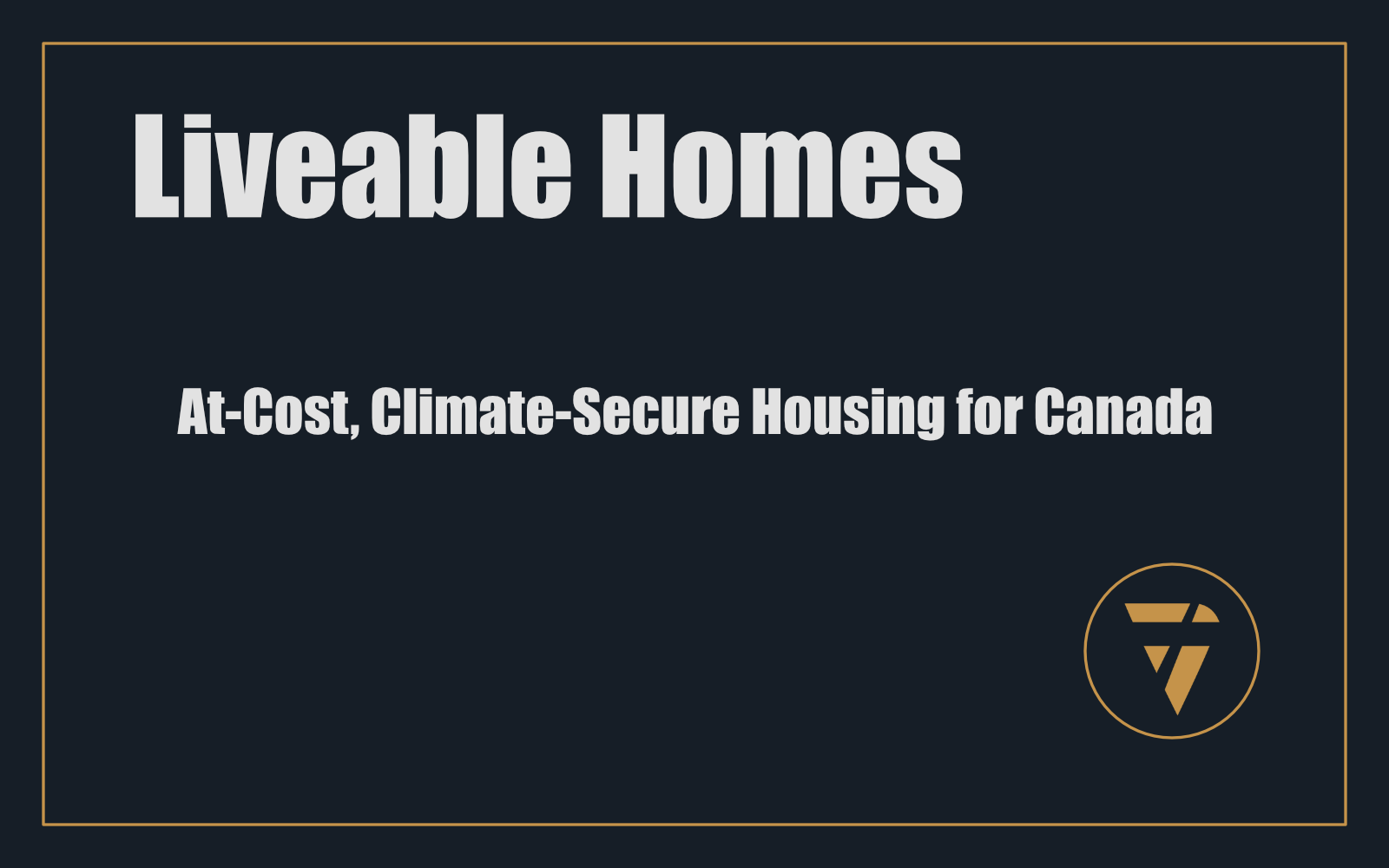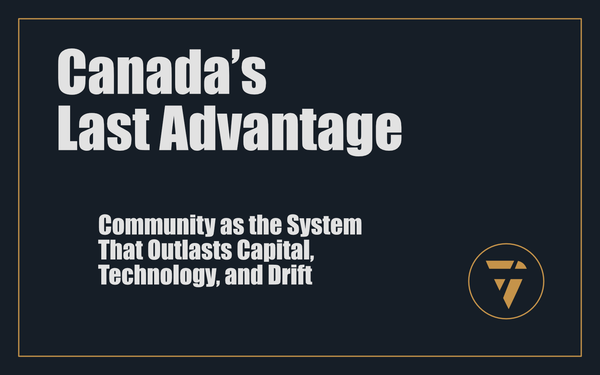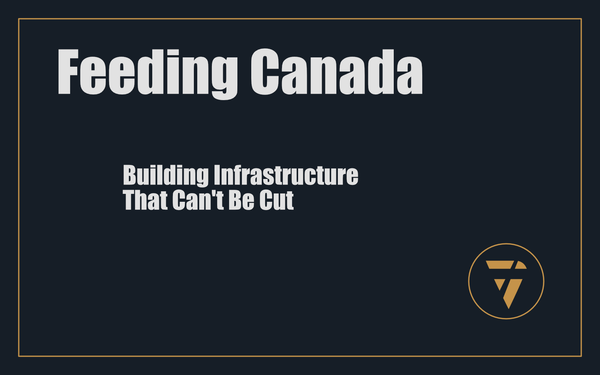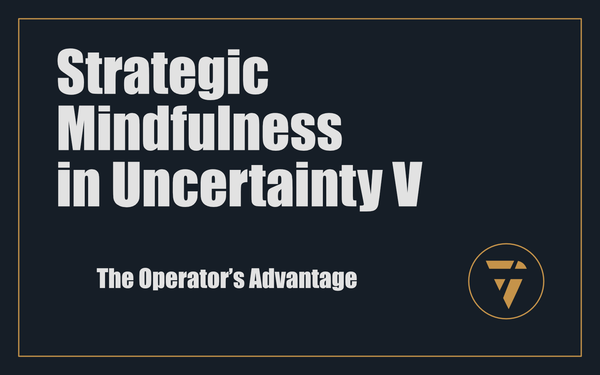Liveable Homes

At-Cost, Climate-Secure Housing for Canada
Canada’s housing market is not suffering from a shortage of materials or land. It suffers from a shortage of integrity in the way homes are conceived, financed, and delivered.
For decades, developers have built to extract, not to endure. The result is a landscape of houses that meet code but fail climate, fail comfort, and fail affordability. The average markup on a new home in a mid-sized Canadian city now exceeds forty per cent. Those margins don’t fund better construction; they feed the financial machinery of speculative development.
The system has been captured by its own yield curve. When shareholders demand quarterly return, the builder cannot afford to build a house that lasts fifty years. The buyer is no longer a client; they are an exit.
The outcome is visible in every market report: working families priced out, first-time buyers in permanent deferral, a generation renting the future they were supposed to own. The product is expensive and fragile; the model is profitable and unsustainable.
A Different Foundation
The corrective begins with one simple inversion: build at cost, defer profit, align incentives.
When a home is delivered at cost, the buyer pays only what the build actually required—materials, labour, sitework, management, verification. No speculative margin, no hidden finance load, no soft-cost inflation to pad developer yield.
Profit is deferred until the homeowner realises appreciation. When the home sells, that appreciation is shared under covenant. The builder is rewarded only when the buyer prospers. Every actor now wants the same outcome: a durable, efficient, valuable home that performs.
This inversion restores trust. It converts the builder from a seller of inventory into a custodian of value. It transforms the housing transaction from extraction to stewardship.
Climate-Secure by Design
Building at cost is not an excuse for mediocrity; it’s the condition that allows excellence. Once speculative profit is removed, capital can be directed to what actually matters—performance and permanence.
The technical standard is Passive House certification. Airtightness below 0.6 ACH50, continuous insulation, triple-glazed assemblies, balanced ventilation, and heat-pump mechanicals sized for the climate. The result: up to 90 % reduction in heating energy, stable indoor temperature, filtered air, and verified carbon reduction.
Every specification is measured, modelled, and tested. Each home is commissioned with blower-door verification, mechanical balancing, and documented performance data. Comfort is not a promise; it's a metric.
A home built this way is not just efficient—it's climate secure. It will remain habitable when grids strain, when temperatures swing, when fuel costs spike. It's an asset of resilience in a volatile world.
The At-Cost Delivery System
A climate-secure home is achievable only if the build process is as disciplined as the design.
The delivery rail is a six-month stage-gated sequence:
- Reservation and design freeze.
- Permit and procurement of long-lead items.
- Foundation and envelope installation using panelised systems.
- Mechanical, electrical, and plumbing integration.
- Interior completion and exterior finish.
- Commissioning, verification, and handover.
Each stage has entry and exit criteria, quality assurance sign-off, and documented accountability. The system runs like production, not speculation. Time, cost, and quality are controlled by process, not personality.
Integrated Finance and Insurance
The question every investor asks is how a zero-profit builder survives. The answer: the builder is not the business. The system is.
Liveable Homes—the operating name for this model—functions as an integrated finance, insurance, and maintenance enterprise. Construction is executed at cost; the enduring revenue streams arise from the stability of the portfolio.
Each home carries a performance-based insurance policy and a maintenance framework underwritten by the company. Lower energy use and predictable envelope integrity reduce claims and improve actuarial certainty. The same data that verifies Passive House performance also lowers financial risk.
The capital structure mirrors a closed-loop fund. Buyer deposits and construction financing cover the build. When appreciation is realised, the builder’s share recycles directly into the next project. The system compounds through repetition. No extraction, no depletion—just rotation of verified value.
Proof Through the Pilot
The first demonstration is simple and direct:
ten climate-secure homes, each 900+ sq ft, two bedrooms, two baths, delivered for under $400 per sq ft and sold for less than $500,000 turnkey.
Each home is pre-sold with fixed-price contracts, lender pre-approval, and transparent cost sheets. Each will be certified to Passive House standards and delivered within twenty-six weeks. Every cost, delay, and performance outcome will be published.
This is not a marketing claim; it's an experiment in public accountability. When the numbers are visible, the truth becomes unarguable: a family can live better for less when the builder is aligned with them instead of the market.
The Economic Mechanism
Once proof exists, the economic logic is unassailable.
A family comparing two options—
- a code-minimum house at $800,000 built to maximise developer yield, or
- a Passive House at $400,000 built at cost—
will choose the latter every time.
The lower monthly outflow, lower maintenance cost, and higher resale stability make it the rational choice.
Developers tied to front-loaded profit cannot compete; they cannot cut price without destroying their own debt coverage. The market self-corrects. Quality rises, prices fall, because information is no longer hidden.
Policy and Institutional Fit
For governments and capital institutions, this model aligns perfectly with public and fiduciary interests.
- Affordability: verifiable cost transparency eliminates the need for subsidy.
- Sustainability: certified performance meets and exceeds net-zero targets.
- Speed: panelised, pre-approved designs halve delivery time.
- Risk reduction: predictable performance lowers default and insurance loss.
- Economic development: training programs build skilled local trades.
It achieves the objectives of public housing policy without public cost, using market precision instead of bureaucratic delay.
Institutional investors gain a low-volatility asset class—a portfolio of verified, appreciating, low-risk homes with stable returns. Municipalities gain supply without subsidy. Homeowners gain dignity without debt strain.
Scaling the System
Replication is logistical, not conceptual. Once the cost, schedule, and certification processes are proven, the system expands through three channels:
- Licensed builders adopting the at-cost, deferred-profit covenant.
- Municipal partnerships providing serviced land in exchange for affordability guarantees.
- Capital pools recycling appreciation into new builds.
Each region becomes self-propelling. Trade training, supply contracts, and financing adapt to local conditions, but the governing principle remains the same: cost transparency, verified performance, deferred profit.
The New Definition of Value
In the existing market, value is defined by location and scarcity. In the new market, value is defined by verified performance and affordability. The home that costs less to live in, lasts longer, and holds comfort through any season is worth more—ethically and economically.
The Liveable Homes model restores that equation. Profit flows from excellence, not scarcity. The builder succeeds by building right, not by selling high.
Governance and Proof of Integrity
The credibility of this model depends on discipline. Every project operates under independent audit. Every cost ledger and performance test is open to investors and buyers. Governance is not an afterthought; it's the foundation of trust.
Transparency replaces marketing. Metrics replace adjectives. That's how the market learns to believe again.
The Consequence of Success
When the pilot performs as designed, Canada gains more than ten homes; it gains a blueprint. This proves that affordable, climate-secure housing can be built without subsidy or compromise.
Once data is public, the precedent is irreversible. Buyers will no longer accept inflated prices for inferior construction. Lenders will no longer ignore the risk differential between efficient and wasteful buildings. Municipalities will no longer permit delay under the excuse of complexity.
The at-cost model becomes the new benchmark. The market reorganises itself around the standard you set.
The Closing Principle
This is not a moral argument. It's a structural correction. Housing fails when profit is extracted before performance is proven. It succeeds when profit is earned only after people have lived well in what you built.
The at-cost, climate-secure model restores that order. It turns the home back into a durable public good built through private discipline.
Build it right, price it honestly, share in its future value. That is how you rebuild trust, restore affordability, and prepare a nation for the climate to come.
This is what I’m working on. Tell me what you think, I enjoy the conversation! Subscribe and follow the work in real time.
Thanks!
B

You pay for developers’ profits, not for a home.
Passive House, fixed price, six-month delivery, under $500,000.
We build at cost; profit only on resale — comfort, low bills, real equity.
PS -






